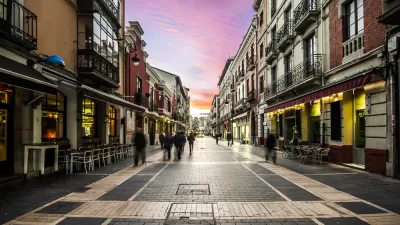San Francisco is expanding a program of traffic light synchronization for cyclists, which is patterned after successful applications in Copenhagen, Amsterdam and Portland.
Aaron Bialick reports that the city's second green wave is now operating on 14th St. after the San Francisco Municipal Transportation Agency began work on the corridor in March. The first green wave has been operating successfully on Valencia St. since January of last year.
SF Bicycle Coalition Communications Director Kristin Smith said the organization "is very pleased to see the ‘green wave' tool used on more and more of San Francisco's key bikeways."
"It's a simple but powerful way to prioritize bike traffic and make bicycling even more convenient and comfortable," she said. "Of course, it's not just good for bike traffic - by pacing traffic to a human speed, green wave streets are safer for everyone."
"(In June), staff from the SF County Transportation Authority plans to propose 'four to six potential new Green Wave corridors along the existing San Francisco Bike Network.' The SFCTA board is expected to approve $71,000 in Prop K sales tax funds in June to plan and implement them, and the document says they could be completed between April and October of next year."
Reporting on the city's first green wave project in January of last year, Aaron Bialick notes that the Valencia St. green wave is not of the same scale as it's more famous cousin.
"The other more widely known Green Wave is Copenhagen's Nørrebrogade, the busiest bicycle street in the Western world, carrying an average of 38,000 cyclists per day with bike lanes as wide as 16 feet. There, implementation of the green wave has also improved the flow of its heavy bus traffic."
[Contributor's note: See the photos of the Green Wave signage above Valencia St. and in Copenhagen.]
Take a short ride on Nørrebrogade by viewing the video on Copenhagenize.com: Surfing the Green Wave in Copenhagen.
Thanks to SF. Streetsblog
FULL STORY: SFMTA Installs Second Green Wave for Bikes on 14th Street

Manufactured Crisis: Losing the Nation’s Largest Source of Unsubsidized Affordable Housing
Manufactured housing communities have long been an affordable housing option for millions of people living in the U.S., but that affordability is disappearing rapidly. How did we get here?

Americans May Be Stuck — But Why?
Americans are moving a lot less than they once did, and that is a problem. While Yoni Applebaum, in his highly-publicized article Stuck, gets the reasons badly wrong, it's still important to ask: why are we moving so much less than before?

Using Old Oil and Gas Wells for Green Energy Storage
Penn State researchers have found that repurposing abandoned oil and gas wells for geothermal-assisted compressed-air energy storage can boost efficiency, reduce environmental risks, and support clean energy and job transitions.

Minneapolis Bans Rent-Setting Software
Four cities have enacted restrictions on algorithmic software that can inflate rent costs.

Oakland to Add 244 New EV Chargers
Oakland plans to launch its new charging network at eight locations by the end of 2025.

Jane Goodall Inspires with Message of Hope, Resilience, and Environmental Action
Speaking in Pasadena, Jane Goodall offered a hopeful and inspirational message, urging global compassion, environmental responsibility, and the power of individual action to shape a better future.
Urban Design for Planners 1: Software Tools
This six-course series explores essential urban design concepts using open source software and equips planners with the tools they need to participate fully in the urban design process.
Planning for Universal Design
Learn the tools for implementing Universal Design in planning regulations.
Heyer Gruel & Associates PA
City of Moreno Valley
Institute for Housing and Urban Development Studies (IHS)
City of Grandview
Harvard GSD Executive Education
Salt Lake City
NYU Wagner Graduate School of Public Service
City of Cambridge, Maryland





























